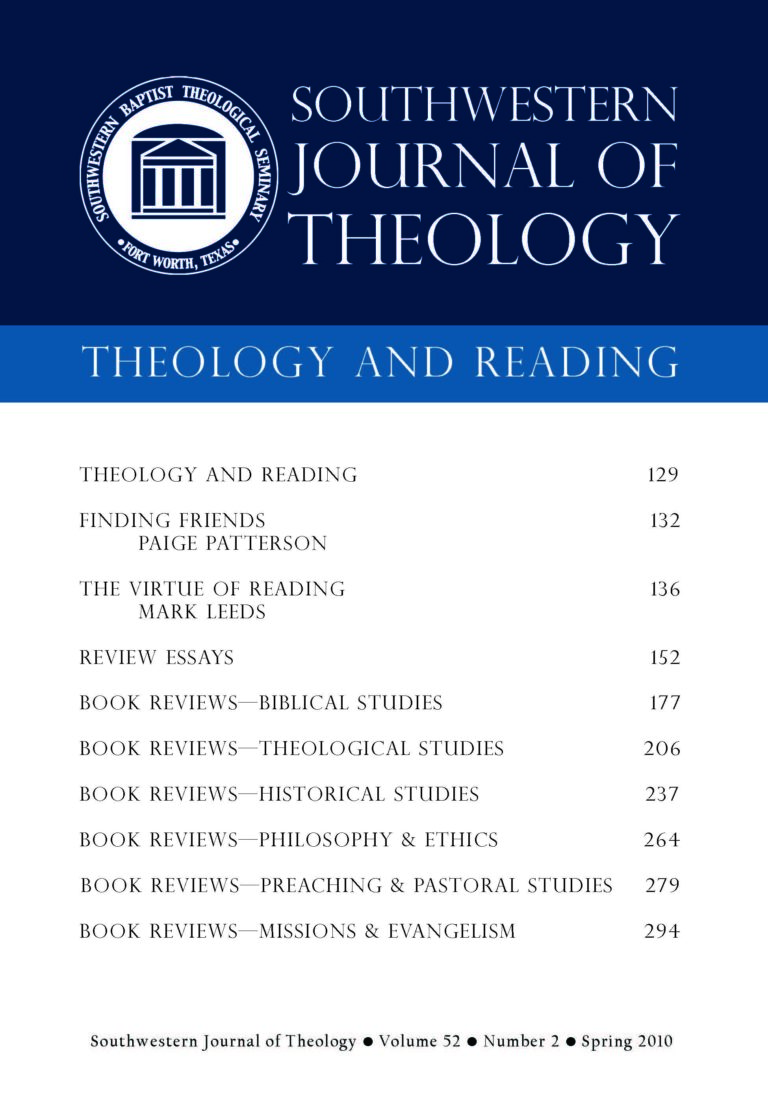
Theology and Reading
Southwestern Journal of Theology
Volume 52, No. 2 – Spring 2010
Managing Editor: Malcolm B. Yarnell III
By James France. Kalamazoo, MI: Cistercian, 2007. 435 pages. Softcover, $32.97
James France’s work is a unique contribution to the Bernardian iconography study in three ways. First, this book advances a provocative thesis requiring a reevaluation of the traditional argument that Bernard was “indifferent” and “at worst inimical to the visual arts” (ix) and that no true image of Bernard was produced in his own day. Second, the book also provides a valuable CD that contains 964 medieval images of Bernard that might not be available elsewhere. Third, France attests that the Bernardian iconography is essential to the understanding of medieval spirituality in Europe between the twelfth and sixteenth centuries. France does not exaggerate the importance of the Bernardian iconography, for few of Bernard’s contemporaries have been depicted, and none of them impacted the spiritual life of common people as Bernard did. Medieval Images shows that an iconographical study of an ancient religious figure does not focus on his or her theological and ecclesiastical contributions. Rather, such study reveals how his or her later followers understood that person as a guide in their spiritual journey. The medieval images of Bernard display the way the medieval European Christians appropriated the spiritual legacy of Bernard as a spiritual assistant, teacher, and preacher.
The image of Mary offering her breast milk to Bernard suggests that people saw him as a qualified preacher and teacher whom Mary endorsed. This image has two theological implications. One is that the medieval Christians in the twelfth century already held to a high Mariology, describing Mary as the mediatrix of salvation. The images of Bernard’s paying special devotion to Mary depict her as the source of faith since they portrayed her as a secondary mediator. To be associated with or supported by Mary is to be commissioned by Christ who is in his mother’s bosom. Bernard himself did not advocate this close relationship between Bernard and Mary although he did promote a high Mariology. And yet, this is what medieval Christianity appropriated most from Bernard. The other implication is that both Mary—on whom Bernard heavily meditated—and the Cistercian abbot himself became subjects of folk piety. The last chapter of La Divina Commedia introduces Bernard as Dante’s guide on his pilgrimage to Paradise. Bernard could intercede with Mary to give Dante special grace, which allowed the Italian poet to enter Paradise.
Interestingly, the iconography of Bernard explains how later medieval people could use him in order to justify a new religious practice that he opposed. In spite of his strong devotion to Mary, Bernard objected to the ecclesiastical observance of the immaculate conception of Mary because that practice was completely new in the church tradition “‘of which the Church knows nothing, of which reason cannot approve, and for which there is no authority in tradition’” (271). However, Roman Catholics in the sixteenth century began to appeal to Bernard in order to defend the legitimacy of the doctrine and the Feast of the Immaculate Conception of Mary. In fact, one of the Franciscan images portrays Bernard, along with Augustine and Thomas Aquinas, as an ecclesiastical supporter of the immaculate conception of Mary. As a result, some began to interpret Bernard’s reference in the sermon on the Song of Songs regarding the spotlessness (immacula) of the soul as a reference to sinless Mary. Therefore, a contemporary reader can read Bernard’s own objection to the doctrine of the immaculate conception of Mary from his writings but view Bernardian images that promote his support of the same doctrine.
An image of Bernard chaining a demon (or the Devil) also shows the influence of the legacy of Bernard on medieval lay pietism. Neither Bernard nor the order of Cistercians is the source of this image. In the later Middle Ages Bernard appears in prayers as a powerful intercessor who controlled the Devil. It is not surprising that both Erasmus and Luther condemned the Verses of Bernard, a prayer that calls for Bernard’s help to overcome the temptations of the Devil and that promises indulgences in Bernard’s name.
Frank’s work might not be a good theological source from which a Protestant reader might deepen his or her Protestant faith, but if that person wants to know medieval folk pietism in the Roman Catholic Church Frank must be a primary source.





